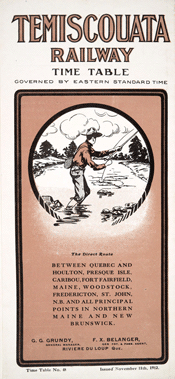Temiscouata Railway Reporting mark: TMC
The Temiscouata Railway (TMCR) was first surveyed in 1846. Between 1864 and 68 it was surveyed once again under the direction of Sandford Fleming. Fleming had been appointed to provide recommendations on potential routes for the future Intercolonial Railway. Due to limited strategic and commercial importance, the Temiscouata failed to make the final cut both times. Plans languished for the next two decades.

Publisher: Canadian National Railways
The Temiscouata Railway finally came back to life in 1885. Construction began in 1886 after the company received subsidies totalling $9,000 per mile from the federal government and the provincial governments of Quebec and New Brunswick. The 82-mile long (135 km) railway which ran between Riviere du Loup and Edmunston took three long years to build. During construction, an additional 31-mile (50 km) extension from Edmundston to Connors was added to the plans. The railway finally opened in January 1889.
The Temiscouata Railway was well financed and well equipped. Rolling stock consisted of five locomotives, 41 box cars, 54 flat cars, seven frost proof and two baggage cars. Passengers could choose from three first class, two second class or two combination first and second class accommodations. As well there was the usual assortment of machine shops, engine sheds, turntables, offices, stations, and utility cars such as snowplows to cover the 19 stops on the line.
The company had hoped to profit from the lumber trade and passenger excursions. Unfortunately lumber traffic was disappointing with trade flowing in the opposite direction. In 1898 the British bond holders took over control and operation of the railway.
Further problems arose in 1912 following the opening of the government-owed National Transcontinental Railway (NTR). The NTR was planned without regard for existing rail traffic, including that of the government-owned Intercolonial Railway (IRC), hardly a competitor. The NTR cut severely into the Temiscouata's business, compounding its existing financial troubles.
In 1918 the NTR and IRC were both rolled into the newly formed Canadian National Railway (CN). By the 1920s, CN began taking a serious look at the Temiscouata Railway. Weighted down by a heavy debt load from the bankruptcies of both the Grand Trunk and Canadian Northern Railways, and also under pressure from the government to turn a profit, CN was in no position to take on another money loser. Instead in 1929, they decided to give the railway a helping hand by providing it with preferential treatment in the form of favourable allowances on interline traffic.
The Temiscouata struggled through the depression barely managing to keep its head above water. By 1941 things were beginning to look up. The railway abandoned 14 miles (22.5 km) of line and began using the CN tracks between Edmiundston and Baker Brook. This resulted in a substantial reduction in operating costs.
Despite a somewhat improved financial position, business was down and the railway was still hurting. In 1949 it suffered a major setback when the two-stall engine facility in Riviere du Loup was destroyed by fire. Since the railway still served an important function, CN entered into negotiations with the British bond holders. They ended up purchasing the railway for $480,000. In 1950 it was merged into CN's general operations.
Changing industrial and traffic patterns took their toll. The Temiscouata remained in operation until the 1970s when the abandonment slowly began. The shutdown was gradual and took place in stages. CN continued to maintain the railway as long as there was limited industrial traffic. By 1993 it was all over. The Temiscouata Railway was shut down for good, ending a proud legacy that lasted just over 100 years.
